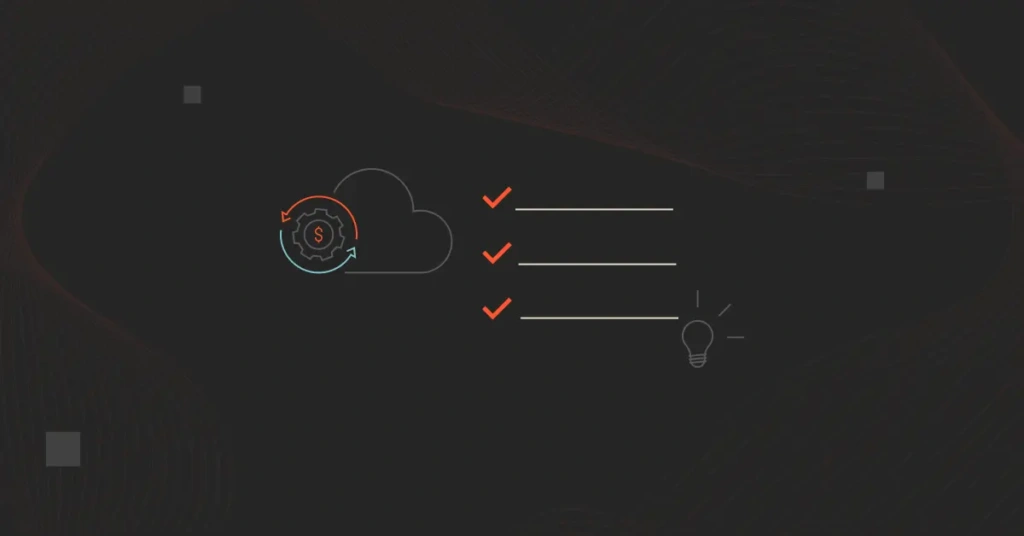Organizations face increasingly complex cloud environments — from hybrid clouds to multi-cloud deployments — where costs can quickly spiral without real-time visibility and intelligent controls. This is why setting clear goals for cloud cost optimization is necessary to keep your organization proactive.
The key to success lies not just in setting goals, however, but in ensuring those goals are clear, realistic, and supported by continuous measurement and actionable insights. In other words, your team must know where they’re headed and have full confidence that they can get there.
To help you find the right path, we’ll share cloud cost optimization examples and goals tailored to different stages of maturity — from building foundational visibility to advanced, AI-driven cost intelligence.
Before exploring specific goals, it’s important to understand your current position in the cloud cost journey. At CloudZero, we like to break the process down into three stages: Crawl, Walk, and Run. Your mindset is important here — as the saying goes, you must crawl before you can walk, and walk before you can run.
To help you get started, first consider what’s driving your cloud expenses and why, if you haven’t already, now may be the best time to start your cost control journey:
You may be starting from nothing, or you might have already picked some low-hanging fruit, and you’re eager to move on to the next steps.
Advanced cost intelligence doesn’t happen overnight, so it’s okay if your company is still working on early goals.
It’s also important to follow each stage in order. Trying to jump ahead and force huge improvements before you’ve built a strong foundation will likely lead to setbacks and frustration. But the right mindset will help you achieve steady, sustainable progress and build a strong cost-conscious culture.
With that in mind, here are cloud cost optimization examples suitable for each stage of the cost journey.
Crawl Stage Goals: Lay A Foundation
Goal #1: Define a broad objective
What would you like to accomplish by optimizing costs? Are you working toward a lower budget? A stronger margin? Do you just want to conserve some cash to help your business withstand the fluctuating economic climate?
Your underlying objective will point you in different directions as you progress through each stage. If you’re under pressure to improve your margins, for example, you’ll need to focus heavily on unit economics. Whereas if you’re orienting more toward saving the most cash possible, you might care more about overall cost visibility so you can pare down the items that cost more than they’re worth.
Goal #2: Devise a way to make progress visible in real time
Some goals — staying under a specific monthly budget, for instance — should be continuously measured every day. It doesn’t help to set a budget goal if you only evaluate your progress after impactful decisions have already been made. You might hit your goal, but you could also blow past it and have no idea until the bill lands on your executives’ desks. You’ll want to focus on the trend line over time, not just the final number at the end of the month.
CloudZero’s platform is one option for tracking costs on a daily basis. Engineers and other employees who make decisions that impact cost can receive updates via Slack to make sure they’re on track to reach that month’s goal. If it’s the 15th and the team is falling short, they’ll know they need to make some adjustments before the damage is done.
Goal #3: Start breaking down costs into smaller and smaller pieces
There are three main components that affect cloud costs. First, there’s your provider: AWS, GCP, or Azure. The second is the price you pay for each service, and the third is how much you use each service. You likely won’t want to optimize by switching providers, so the second two factors should be your focus.
Can you identify how much you’re paying for each service? You’ll need a more advanced way of looking at costs than simply glancing at your provider’s monthly overview. If you’ve completed these goals in order, you should be able to use your day-by-day cost tracking method to achieve this visibility.
Try to break your costs down as granularly as possible. Instead of simply measuring your total EC2 costs, for example, you’ll ideally want to track the cost of each component that contributes to the overall total.
If all you know is that you’re spending a lot of money on EC2, you won’t know which engineering team to talk to or which product to tweak to fix the problem. But breaking that total cost down allows you to see which products, features, or teams are contributing the most toward the high cost.
Goal #4: Purchase reservations
Once you’ve tracked your usage and costs for a while, you will be able to identify some places where your service remains relatively stable from month to month. These are prime opportunities to save some money by reserving instances with your provider at a lower rate than your current on-demand rate.
In the crawl phase, it’s best to avoid biting off more than you can chew in prepaid reservations. Start by covering around 10% of your resources with reservations and monitor how that change impacts your costs over time. As you learn which areas of usage are stable, you can gradually increase that percentage so more of your resources are covered at a discounted price.
Goal #5: Identify underutilized resources
Mistakes happen. Every once in a while, an engineering team may open up a few instances to test out a new project and then forget to close them again. That could mean your company is paying for instances that aren’t being used.
As you start getting a clearer understanding of your costs and usage by tracking granular metrics, you can identify these wasted resources and close them down.
Walk Stage Goals: Get Comfortable With Tracking Cost
Goal #6: Cultivate a culture of cost optimization in your teams
You’ve identified some opportunities for savings and closed down any underused resources. Now it’s time to develop a culture around making smart cost decisions in your organization.
Keeping cost considerations at the forefront will help to prevent your team from making expensive mistakes or suboptimal decisions simply because they weren’t thinking about the potential impact to the bottom line.
Part of establishing cost optimization as a priority is encouraging each team member to take advantage of the real-time visibility afforded to them by your cost-tracking platform. If you’re using CloudZero, our automated updates and convenient Dimensions views will keep everyone aligned with little outside effort needed.
By the time you’ve reached the walk stage, your finance and engineering teams should both have a consistent habit of checking usage throughout the month, identifying opportunities to save a little bit here and there, and pointing out potentially wasteful areas.
Goal #7: Increase reservation coverage
In the earliest phases of your cost journey, you may not have had the information to confidently commit to reserved instances. Now, you should not only see whether your initial explorations into reservations have been successful, you can also identify other opportunities to reserve instances for savings.
If almost half of your usage is relatively consistent and stable, it’s realistic to aim for 40% to 50% coverage in the walk stage.
Goal #8: Right-size your instances
Perhaps early on you operated with caution and reserved instances that turned out to be far too large for your actual needs. Or, perhaps you underestimated your actual usage and you’ve been trying to compensate for that decision ever since. Now is the time to shrink or grow your instances as needed.
The goal is to pay for only as much as you’ll use, without coming in too far over or under your target.
Goal #9: Break costs down even further
You’ll want to feel comfortable tracking your costs per product, per feature, per team, per customer, and any other comparisons that make sense for your situation. Once you’re able to look at your data and confidently see trends, you can Run at full speed.
Run Stage Goals: Make Business Decisions With Confidence
Goal #10: Drill down into unit economics
- Which customers cost the most money? Does the revenue generated by those customers make their costs worthwhile?
- Which customer segment has the best margin?
- What’s your top-performing product in terms of pure revenue? Is it still your top performer if you compare based on margin?
- Which feature gives the best return on investment?
You’ll need to clearly see and track your revenue per customer, per product, and per feature to be able to answer these questions. Utilizing these unit economics allows you to see which areas could use some optimization and which have been surprisingly successful. Those unexpected heroes could become your templates for future innovations.
You might have a product that costs far more than any other product you offer, but it also brings in five times as much revenue as your other products. In the earlier stages, you lacked this context. You might have seen the sky-high price tag and assumed this product urgently needed to be optimized.
But now, you can use unit economics to discover that this product’s ROI is actually astounding in comparison to other products, and your optimization efforts would be better spent elsewhere.
Goal #11: Look for additional savings opportunities
You’re confident making major infrastructure decisions based on high-level intelligence, and you’ve put a substantial amount of your resources into reserved instances with discounted pricing. You can certainly continue to look for additional reservation opportunities, but now that you have enough information, you don’t have to stop there.
AWS Spot Instances may help you take advantage of unused resources offered at a lower price, and every cloud provider has enterprise discounts that can open up a whole new world of pricing tiers and negotiations. Armed with the details and context you’ve gathered so far, you can recognize suitable opportunities that could be worth exploring.
Additionally, automation tools like native AWS savings plans can streamline these steps. allowing you to set tags and configurations and automatically manage your savings. CloudZero partners with two companies that can help you do just that.
Goal #12: Strive for continuous improvement
Not all optimization in the run stage has to come from massive changes. If you know your current features have a cost per customer of $120, for example, you can set goals to lower a particular feature to $110 per customer.
You know exactly where your costs are coming from, you know which products or features need to be optimized, and you know how to architect a solution. This kind of deep understanding of your business allows you to make small, iterative improvements that will bring huge rewards with minimal risk over the long term.
With CloudZero, You Can Run Faster Than You Think
All of this cost tracking might sound like a tedious and overwhelming process, but it doesn’t have to be.
CloudZero’s automatic cost tracking, real-time updates, and customizable dashboards put crucial contextual information in front of every team member, so that each person can make educated decisions aligned with the company’s goals.









